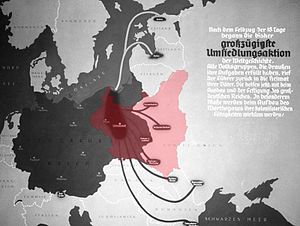|
重返帝國
重返帝國(德语:Heim ins Reich;意为“回到帝国故土”)是阿道夫·希特勒在第二次世界大战期间奉行的外交政策。此政策于1938年开始,希特勒的倡议旨在说服所有居住在纳粹德国(例如奥地利、捷克斯洛伐克和波兰西部地区)以外的德意志裔人口努力從这些地区“重返”到大德意志帝國中。他還要求德意志人而且还要從自《蘇德互不侵犯條約》簽訂後不歸屬德國的波蘭東部地區西遷。重返帝國政策的對象主要是《凡尔赛條約》後新生的波兰以及其他德国大量居民居住的地区,例如蘇台德,但澤以及1939年10月6日以后的欧洲东南和东北地区[2]。 这项政策的实施由VoMi(Hauptamt Volksdeutsche Mittelstelle;黨衛隊國外德意志民族事務部)管理。作为納粹黨的国家机构,它处理了所有關於德意志裔问题。到1941年,VoMi已由党卫军控制[2]。 歷史1939年~1944年"重返帝國"在被佔領的波蘭參見
參考資料
|
||||||||||||||||||
Index:
pl ar de en es fr it arz nl ja pt ceb sv uk vi war zh ru af ast az bg zh-min-nan bn be ca cs cy da et el eo eu fa gl ko hi hr id he ka la lv lt hu mk ms min no nn ce uz kk ro simple sk sl sr sh fi ta tt th tg azb tr ur zh-yue hy my ace als am an hyw ban bjn map-bms ba be-tarask bcl bpy bar bs br cv nv eml hif fo fy ga gd gu hak ha hsb io ig ilo ia ie os is jv kn ht ku ckb ky mrj lb lij li lmo mai mg ml zh-classical mr xmf mzn cdo mn nap new ne frr oc mhr or as pa pnb ps pms nds crh qu sa sah sco sq scn si sd szl su sw tl shn te bug vec vo wa wuu yi yo diq bat-smg zu lad kbd ang smn ab roa-rup frp arc gn av ay bh bi bo bxr cbk-zam co za dag ary se pdc dv dsb myv ext fur gv gag inh ki glk gan guw xal haw rw kbp pam csb kw km kv koi kg gom ks gcr lo lbe ltg lez nia ln jbo lg mt mi tw mwl mdf mnw nqo fj nah na nds-nl nrm nov om pi pag pap pfl pcd krc kaa ksh rm rue sm sat sc trv stq nso sn cu so srn kab roa-tara tet tpi to chr tum tk tyv udm ug vep fiu-vro vls wo xh zea ty ak bm ch ny ee ff got iu ik kl mad cr pih ami pwn pnt dz rmy rn sg st tn ss ti din chy ts kcg ve
Portal di Ensiklopedia Dunia

